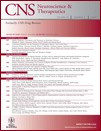Viero C, Shibuya I, Kitamura N, Verkhratsky A, Fujihara H, Katoh A, Ueta Y, Zingg HH, Chvatal A, Sykova E, Dayanithi G. CNS Neurosci Ther. 2010 Jul 7. IF: 2.690

Department of Neuroscience
Abstract:
Is oxytocin the hormone of happiness? Probably not. However, this small nine amino acid peptide is involved in a wide variety of physiological and pathological functions such as sexual activity, penile erection, ejaculation, pregnancy, uterus contraction, milk ejection, maternal behavior, osteoporosis, diabetes, cancer, social bonding, and stress, which makes oxytocin and its receptor potential candidates as targets for drug therapy. In this review, we address the issues of drug design and specificity and focus our discussion on recent findings on oxytocin and its heterotrimeric G protein-coupled receptor OTR. In this regard, we will highlight the following topics: (i) the role of oxytocin in behavior and affectivity, (ii) the relationship between oxytocin and stress with emphasis on the hypothalamo-pituitary-adrenal axis, (iii) the involvement of oxytocin in pain regulation and nociception, (iv) the specific action mechanisms of oxytocin on intracellular Ca2+ in the hypothalamo neurohypophysial system (HNS) cell bodies, (v) newly generated transgenic rats tagged by a visible fluorescent protein to study the physiology of vasopressin and oxytocin, and (vi) the action of the neurohypophysial hormone outside the central nervous system, including the myometrium, heart and peripheral nervous system. As a short nine amino acid peptide, closely related to its partner peptide vasopressin, oxytocin appears to be ideal for the design of agonists and antagonists of its receptor. In addition, not only the hormone itself and its binding to OTR, but also its synthesis, storage and release can be endogenously and exogenously regulated to counteract pathophysiological states. Understanding the fundamental physiopharmacology of the effects of oxytocin is an important and necessary approach for developing a potential pharmacotherapy.
Prof. MUDr. Eva Syková, DrSc., wrote:
Oxytocin is a peptide of only 9 amino acids: the sequence is Cysteine – Tyrosine – Isoleucine – Glutamine – Asparagine – Cysteine – Proline – Leucine – Glycineamide (CYIQNCPLG-NH2). The Cysteine residues form a sulfur bridge. The oxytocin agonists and antagonists are precious pharmacological research tools to study on the central and peripheral effects. The synthesis of oxytocin agonists and antagonists could be achieved by the Merrifield Solid Phase Method. Since oxytocin is eliminated from the circulatory system within minutes, the most precise and reliable way of delivering oxytocin is through i.v. infusion, direct administration into blood and intranasal spray.
Oxytocin receptor ligands, peptides, and nonpeptide molecules, with high specificity are currently available. These ligands are expected to show therapeutic utility for a vast range of applications, e.g., increasing lactation, improving in vitro inseminations, and inducing cardiomyogenesis; and also acting against preterm labor, breast cancer, an over-reactive immune system, osteoporosis, and autism-related disorders.
-mk-
